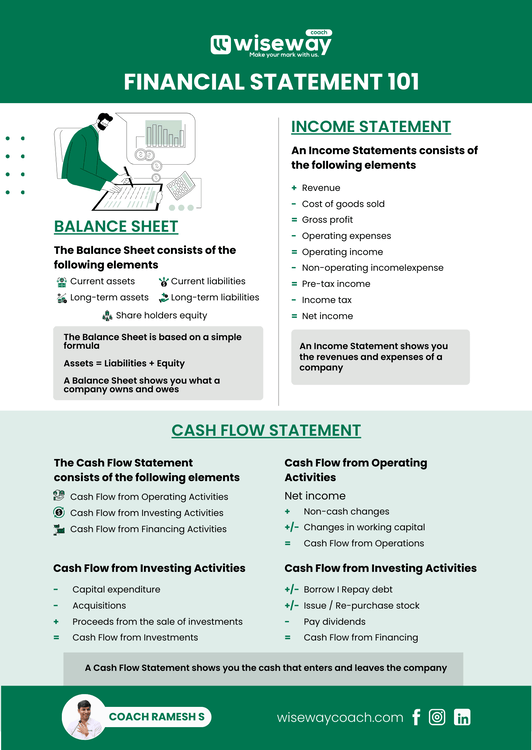Financial Statement
July 4, 2024 2024-11-22 15:15Financial Statement
Financial Statement A Beginner's Guide to Understanding Business Finances
Financial statements are the cornerstone of understanding a company’s financial health. They provide insights into what a company owns, earns, and spends. This guide breaks down the three key financial statements: the Balance Sheet, Income Statement, and Cash Flow Statement.

1. Balance Sheet
The Balance Sheet provides a snapshot of a company’s financial position by showing what it owns (assets) and owes (liabilities and equity).
Key Elements
Current Assets:
Cash, accounts receivable, inventory.
Long-Term Assets
Property, equipment, and intangible assets.
Current Liabilities
Short-term obligations like accounts payable and accrued expenses.
Long-Term Liabilities
Long-term debts and obligations.
Shareholders' Equity
Owner’s stake in the company after liabilities are subtracted from assets.
Formula: Assets = Liabilities + Equity
The Balance Sheet answers: What does the company own, and how is it financed?
2. Income Statement
The Income Statement details the company’s revenues, costs, and profits over a period of time, providing insights into profitability.
Key Elements
Revenue
Total sales income.
Cost of Goods Sold (COGS)
Direct costs of producing goods/services.
Gross Profit
Revenue - COGS.
Operating Expenses
Administrative and selling costs.
Operating Income
Gross profit - Operating expenses.
Non-Operating Income/Expenses
Income or costs unrelated to core operations.
Pre-Tax Income
Operating income +/- non-operating income/expenses.
Net Income
Pre-tax income - Income taxes.
The Income Statement answers: How much revenue does the company generate, and is it profitable?
3. Cash Flow Statement
The Cash Flow Statement tracks the cash coming in and going out, providing a real-time picture of liquidity.
Key Elements
Cash Flow from Operating Activities
Net income adjusted for non-cash changes (e.g., depreciation) and changes in working capital.
Cash Flow from Investing Activities
Cash spent on capital expenditures or received from selling investments.
Cash Flow from Financing Activities
Borrowing, repaying debt, issuing/re-purchasing stock, and paying dividends.
The Cash Flow Statement answers: How is cash flowing in and out of the business, and is it sustainable?

Why Financial Statements Matter
Understanding these statements enables business owners and stakeholders to
- Assess profitability and efficiency.
- Identify financial risks and opportunities.
- Make data-driven decisions to drive growth.
Financial literacy isn’t optional—it’s the foundation of sustainable success.
– Coach Ramesh S

For More Details
Ready to elevate your business? Our tailored coaching programs help entrepreneurs unlock their potential and achieve sustainable growth. Start with a free strategy session to discover your roadmap to success!